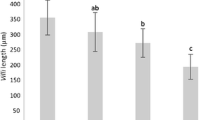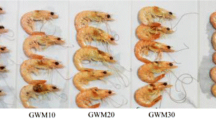Abstract
Algae constitute a major proportion offish food in rice-fish culture system. Study of algal preferences nd their availability in the natural environment might be important for developing natural fish feed. Preparation of ormulated feeds using under-exploited materials such as algae not only reduces production costs, but also increases rocurement accessibility of locally available alternative ingredients. Methodological difficulties were being encountered n the processing and identification of ingested algal material from fish guts during the study. A new approach was thus eveloped to make the analysis easier, simple and accurate. For the purpose, algal ingestion by Cyprinus carpio. L tocked in a rice-fish cropping system was undertaken. The intact guts or gut contents of 25 fishes were transferred directly to five different solid nutrient mediums to study the species of algae consumed by the fish. The method adopted was found to be simpler, accurate and more convenient compared to conventional technique for gut analysis. Moreover, the methodology also reduces the number of fishes ‘sacrificed’ for the study.
Similar content being viewed by others
References
Appier, H. N., (1985). Evaluation of Hydrodictyon reticulatum as a protein source for Oreochromis (Tilapia) nilotica and Tilapia zillii. J. Fish Biol., 27, 327–333.
Appier, H. N. and Jauncey, K., (1983). The utilization of a filamentous green alga [Cladophora glomerata (L. Kutzin)] as a protein source in pelleted feeds for Sarotherodon (Tilapia) niloticus fingerlings. Aquaculture, 30, 21–30.
Attayde, J. L. and Hansson, L. A., (1999). Nutrient recycling by zooplnakton and fish and its effects on algal communities in laboratory microcosms. Oecologia., 121, 47–54.
Azim, M. E., Verdegem, M. C. J., Rahman, M. M., Wahab, M. A., Dam A. A. and van Beveridge M. C. M., (2002), Evaluation of polyculture of Indian major carps in periphyton-based ponds. Aquaculture, 213, 131–149.
Bowen, S. H., (1996). Quantitative description of diet. In:.Murphy, B.R., Willis, D.W. (Eds.), Fisheries Techniques, 513–532, American Fisheries Society.
Brummett, R. E., (1996). Species selection for smallholder aquaculture. NAGA, 19, 19–22.
Chow, C. Y. and Woo N. Y. S., (1990). Bioenergetic studies on an omnivorous fish, Oreochromis mossambicus: Evaluation of the utilization of Spirulina algae in feeds. In: Hirano R., Hanyu, I. (Eds.), Second Asian Fisheries Forum, 291–294, Asean Fish. Soc, Manila, Philippines.
Das, D. N., Roy, B. and Mukhopadhyay, P. K., (2000). Survey on farmers practices of fish farming in deepwater rice environment of West Bengal, India. Aquaculture, 1, 125–139.
Das, D. N., Mitra, K., Mukhopadhyay, P. K. and Chaudhuri, D. K., (1994). Periphyton of the Deepwater Rice Field at Pearapur Village, Hoogly, west Bengal, India. Environ. Eco., 12, 551–556.
Gerloff, G. C, Fitzerald, G. P. and Skoog, F., (1950). The isolation, purification, and culture of blue-green algae. Am. J. Bot, 27, 216–218.
Haroon, A. K. Y, (1998). Diet and feeding ecology of two sizes of Barbodes gonionotus (puntius gonionotus) and Oreochromis spp. in rice fields in Bangladesh. NAGA, 21: 13–19.
Hughes, E. O., Gorham, P. R. and Zehnder, A., (1958). Metal mimicry and metal limitation in studies of metal microbe interactions. In: R. K. Poole, G. M. Gadd, Metal-Microbe Interactions, (Eds.) IRL Press, 1–17
Hynes, H. B. N., (1950). The food of the freshwater sticklebacks (Gasterosteus aculieatus and Pygosteus pungitius) with a review of methods used in the studies of the food of fishes. J. Anim. Eco., 19, 36–58.
Hyslop, E. J., (1980). Stomach contents analysis-a review of methods and their application. J. Fish Bio., 17, 411–429.
Nakagawa, H., Kashahara, S. and Ugiyama, T., (1987). Effect of Ulva meal supplementation on lipid metabolism of black seabream (Acanthopagrus schlegeli Bleeker). Aquaculture, 62, 109–121.
Talbot, C, (1985). Laboratory methods in fih feeding and nutritional studies. In: Tytler P., Calow P. (Eds.) Fish Energetics - New Perspectives, Croom-Hilm, London, 125–154.
Windell, J. T. and Bowen, S. H., (1978). Methods for study of fish diets based on analysis of stomach contents. In: Bagenal T. (Ed.), Methods for Assessment of Fish Production in Fresh waters, 219–226.
Author information
Authors and Affiliations
Corresponding author
Rights and permissions
About this article
Cite this article
Awasthi, M., Dos, D.N. & Singh, R.K. Qualitative algal analysis from the fish-gut: Tested in the rice fish cropping system. Int. J. Environ. Sci. Technol. 3, 89–94 (2006). https://doi.org/10.1007/BF03325911
Received:
Revised:
Accepted:
Published:
Issue Date:
DOI: https://doi.org/10.1007/BF03325911




